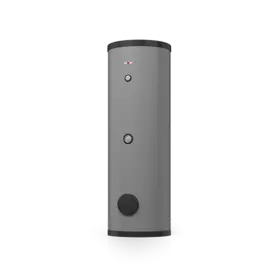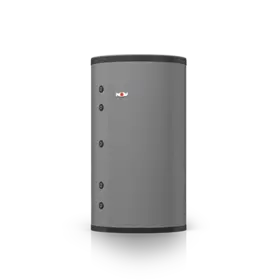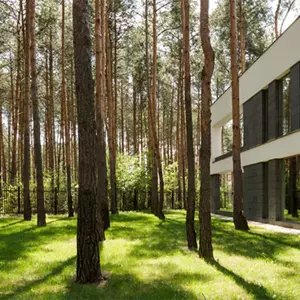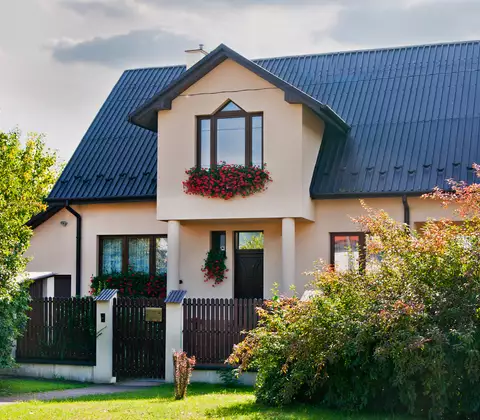
Heat pump with buffer cylinder
When is this option a good idea?
Using a buffer cylinder for heating or DHW heating can increase your comfort levels and improve energy efficiency. However, whether or not combining a heat pump with a buffer cylinder makes sense for you will depends on your individual situation.
The role of the buffer cylinder in a heating system
Most heating systems already have a cylinder for DHW heating - the integrated DHW cylinder. It often makes sense, especially in larger households, to install a similar cylinder for heating purposes to ensure that there is always enough heat available.
Buffer cylinders are similar in design to large thermos flasks and are filled with water that can store heat for a long time. They then release this energy in the water into the system when needed so that the heating system doesn’t have to kick in. This improves the efficiency of your system in every situation.
Overview of the different types of buffer cylinders
Buffer cylinders can be used for DHW heating and central heating backup. These two types of cylinder must be separated for reasons of hygiene, as the DHW (or hot water) should be of drinking water quality. There are two main designs that are used for this purpose:
- Buffer cylinder with freshwater module: In this system, stored heating water flows through a so-called freshwater module, which contains drinking water. The heat energy is transferred to it via a heat exchanger. The freshwater module can be integrated into the buffer cylinder or set up separately.
- Buffer cylinder as combi boiler: In this design, the buffer cylinder is equipped with two separate tanks for heating water and hygienic hot water in the same housing. This means that less space is required for installation, but there is also less capacity available.
Does the heat pump need a buffer cylinder?
Heat pumps are often combined with radiant panel heating systems, such as underfloor heating. Due to the lower flow temperatures of panel heating systems, they work much more efficiently. With these heating systems, a lower flow temperatures of around 35°C to 40°C is sufficient to heat rooms effectively. This means that the temperature of the ambient medium does not need to be heated as much. This reduces the amount of electricity that is used and lowers energy consumption.
But what does this mean when you’re talking about a buffer cylinder? If your building has underfloor heating, it can act as the cylinder itself because of its large surface area and thermal inertia. This works so effectively because of how effectively the screed absorbs heat. Underfloor heating makes the concrete under your feet into a little energy storage system.
That’s why using a heat pump with a buffer cylinder is not strictly required. DHW heating, on the other hand, requires a heat storage tank independent of the heat generator.
Heat pumps with buffer cylinders require special solutions
Not all buffer cylinders are suitable for combination with a heat pump. If an intermediate storage tank is not designed to handle the higher heating water flow of the heat pump, turbulence in the storage tank will result in temperature losses. Ideally, buffer cylinders should be warmest at the top. Experts call this temperature stratification. There is a significant difference between the efficiency of a heat pump combi cylinder and the efficiency of a conventional buffer cylinder. You should therefore seek advice from experts to determine which system is suitable for you.
Find an installer now!
Find competent WOLF heating engineers in your area.
Heat pumps with buffer cylinder for hybrid heating systems
Some homeowners still use so-called hybrid heating systems, especially when retrofitting heat pumps in existing buildings. Instead of acting as the sole heat generator, the heat pump supports an existing heating system like a gas condensing boiler. The buffer cylinder ensures that the required heat is available when needed.
Nowadays, however, hybrid heating systems only really make sense in certain situations. Heat pumps usually provide reliable heating all year round on their own. A conventional heating system, such as a gas or oil heating system, would just take up space, emit unnecessary emissions and makes you dependent on the fluctuating prices of fossil fuels.
Air-to-water heat pumps
CHA-MONOBLOCK
The CHA Monoblock air source heat pump from WOLF is one of the most efficient air source heat pumps on the market. It is low-maintenance, made in Germany and comes with a five-year warranty. It also has a stylish design.
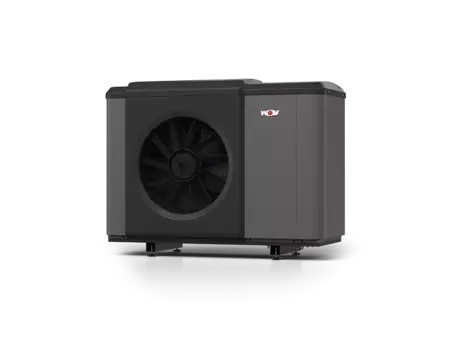
How does using a heat pump with a buffer cylinder affect your electricity bill?
Everybody knows that a heat pump needs electricity to run. Many electricity suppliers offer so-called heat pump electricity tariffs. These are usually night-time tariffs which suppliers provide to meet the lower demand at night in order to increase the stability of the grid. Since a house is heated less at night, the heat generated by the heat pump has to be stored temporarily. A heat pump with a buffer cylinder can make more targeted use of these electricity tariffs by storing the cheap power at night and using it during the day. Some electricity providers even impose blocking times for heat pump tariffs that can be bridged by a buffer cylinder.
Overview of the advantages & disadvantages of using buffer cylinders for heat pumps
Conclusion: Is it worth using a heat pump with a buffer cylinder?
There are a number of advantages and disadvantages to using a heat pump with a buffer cylinder in terms of energy efficiency and costs, depending on the heating system involved. Using a buffer cylinder incurs additional purchase and installation costs, not to mention the space required for installation. If you are using an underfloor heating system, the storage capacity of the radiant heating system is usually sufficient to operate a heat pump without a buffer cylinder. On the other hand, we recommend using a buffer cylinder if you are using the heat pump for DHW heating and/or with conventional radiators.

